Image above: A year late, but finally the Sable Island Institute’s 2019 raffle winner Robert Davis, and his travelling companion Pascale Gusset, visit the island.
During summer 2019, the Sable Island Institute held a raffle for a “Trip for Two to the Sable Island National Park Reserve”. For details about the raffle, see 2019 Trip for Two .
The Institute worked with Fred Stillman of Kattuk Expeditions, to organize the visit. Since 2017, Kattuk has hosted 16 Sable Island tours. Fred, as Kattuk’s Owner & Expedition Leader, has a wealth of experience with small group trips to the island, and shares the Institute’s vision for enhancing visitor experience and understanding of conservation and environmental issues.
The winning raffle ticket was drawn on July 20th, 2019, at White Point Beach Resort, and the winner was Robert Davis. Robert and his partner Pascale Gusset would join four other visitors on a Kattuk tour scheduled for September 14th (with the 15th as a backup date in case of poor flying weather on the 14th). The group would travel to the island aboard a Britten-Norman Islander, a fixed-wing aircraft operated by Sable Aviation.
However, the weather and beach conditions were indeed poor, on both dates. The trip to Sable Island had to be postponed for a year. Robert and Pascale, who had heard enough about Sable Island to appreciate the likelihood of weather delays and other travel uncertainties, looked forward to trying again in September 2020. All part of the Sable Island experience.
So a year later, the trip was booked for September 19th (with the 20th as backup). Also travelling to the island were Kattuk’s guests Aleyah and Johanna Solomon, Annika Posiak, and Randie Graham, accompanied by Fred. On the 18th, heavy rains (46.7 mm) drenched the beach and ruined any hope of finding a landing strip for the fixed-wing aircraft on either of the two available dates. The only option was to charter a helicopter with Vision Air Services Inc.
On September 20th, the six visitors and Fred travelled to Sable Island by helicopter. It was a cool, breezy day with a maximum temperature of 14.5°C, and a northerly wind gusting to 29 knots (53.7 km/h). With broken cloud cover, patches of shadow and sunlight swept across the landscape.
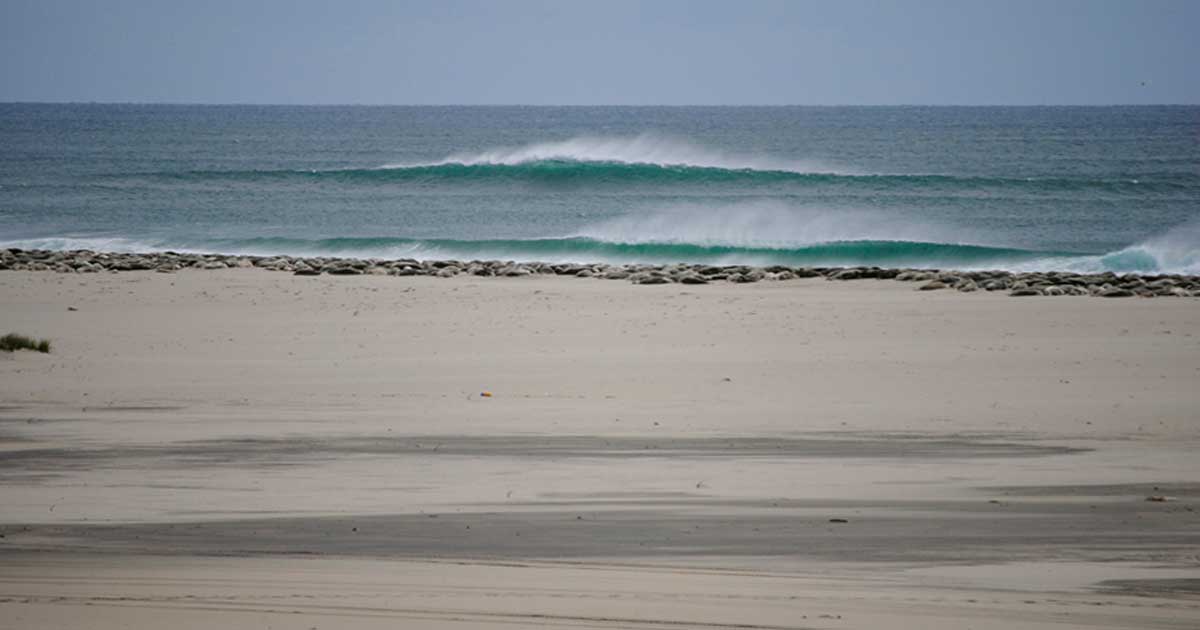 Grey Seals hauled up along south beach, a view from the helicopter on approach (photo Robert Davis). The strong northerly wind is blowing spindrift off the tops of the wave crests.
Grey Seals hauled up along south beach, a view from the helicopter on approach (photo Robert Davis). The strong northerly wind is blowing spindrift off the tops of the wave crests.
Robert & Pascale: “As the pilot flew over the island towards the Sable Island Station, he banked the helicopter in a large turn so that passengers looking out on both sides could take pictures. The approach was swift so the pictures had to be a bit snappy.”
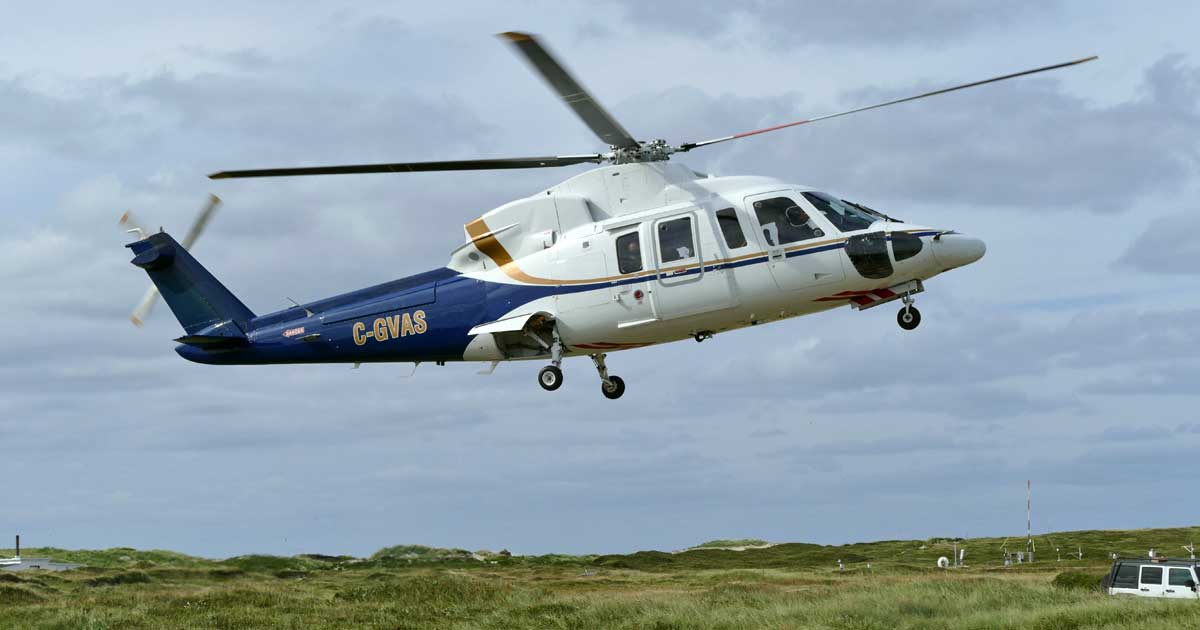 The helicopter descends to land on the helicopter pad. Robert is sitting next to the rear window (the window aft of the passenger door). Vision Air’s Sikorsky SK-76A helicopter can carry eight passengers and has a cruising speed of 257 kph (160 mph).
The helicopter descends to land on the helicopter pad. Robert is sitting next to the rear window (the window aft of the passenger door). Vision Air’s Sikorsky SK-76A helicopter can carry eight passengers and has a cruising speed of 257 kph (160 mph).
 The helicopter landed at 10:15 am. The landing pad is at the east side of the Sable Island Station.
The helicopter landed at 10:15 am. The landing pad is at the east side of the Sable Island Station.
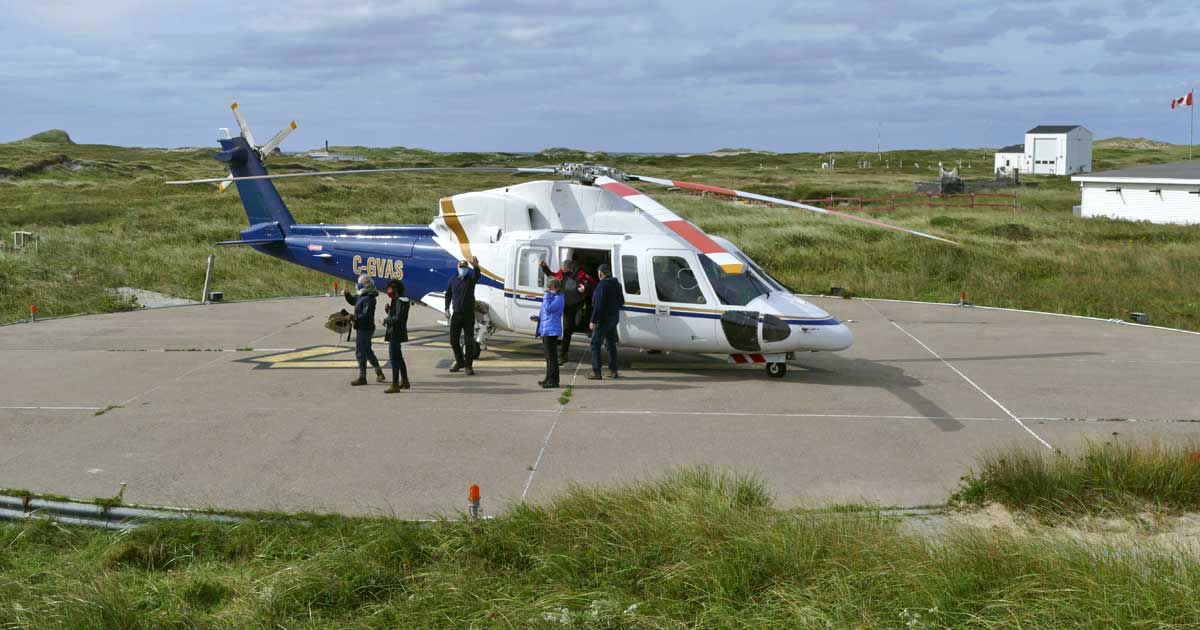 As the passengers disembark, Robert and Pascale set foot on Sable Island for the first time. They were still standing on the helipad, but the concrete for the pad was made with Sable sand.
As the passengers disembark, Robert and Pascale set foot on Sable Island for the first time. They were still standing on the helipad, but the concrete for the pad was made with Sable sand.
Robert & Pascale: “As we landed, we were very pleased to see Zoe strategically positioned to photograph our descent. It was good to see a friendly face upon our arrival even though we were all Covid aware, masked and socially distanced. It was a relief also to be released from the confines of the small flight cabin and to feel the fresh air and openness of the island landscape. The island appeared so small from the air initially, but the land as we stood on it appeared low and as vast as the sky. It was only upon ascending one of the larger hills that we had a full appreciation of the expansive beaches and the hemmed-in nature of the ocean all around.”
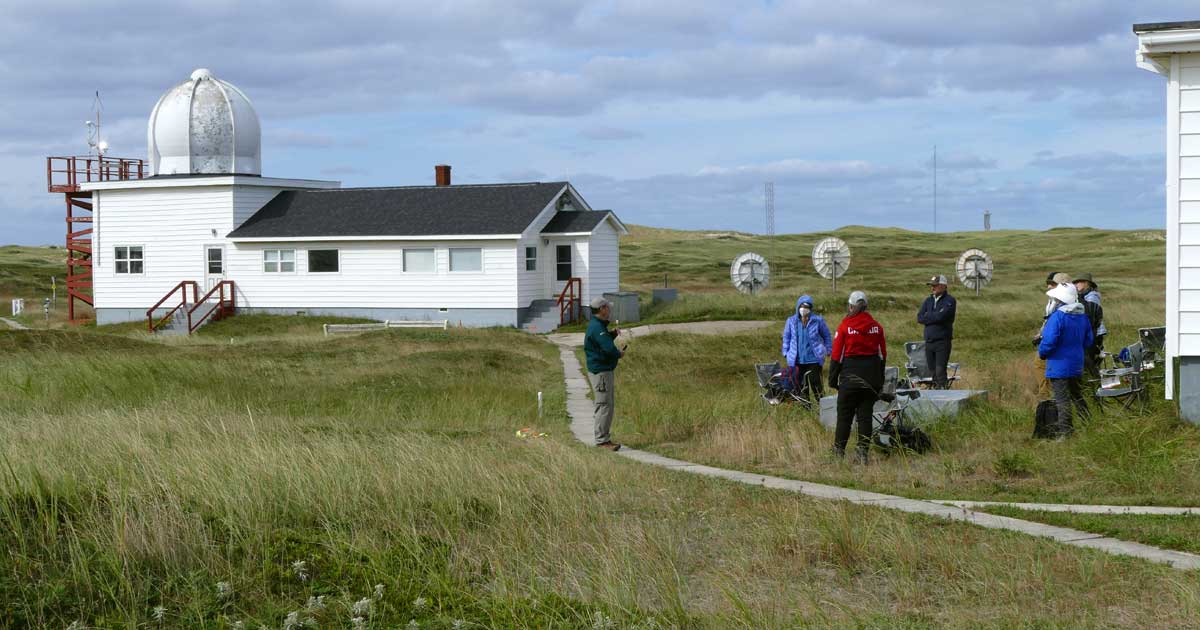
With the visitors assembled in the lee of the Visitors Quarters (VisQ) building at the Sable Island Station, Jason Surette of Parks Canada provided a briefing about the Sable Island National Park Reserve. In the past, these briefings have often been held inside the building, but with COVID-19 precautions, camp chairs were set out for the visitors. The lee side is the south-facing side, so it was out of the wind, and exposed to the passing patches of warm sunshine.
Following the briefing and orientation, the group headed southeast towards an area of freshwater ponds and to the tree, a Scots Pine. There are also a couple of alders on the island, but although they are at least 30 years old, they’ve never made it beyond ‘twig’ stage, always surrounded by, and hidden in, the beach grass. They are a couple of trees who are simply more comfortable being inconspicuous.
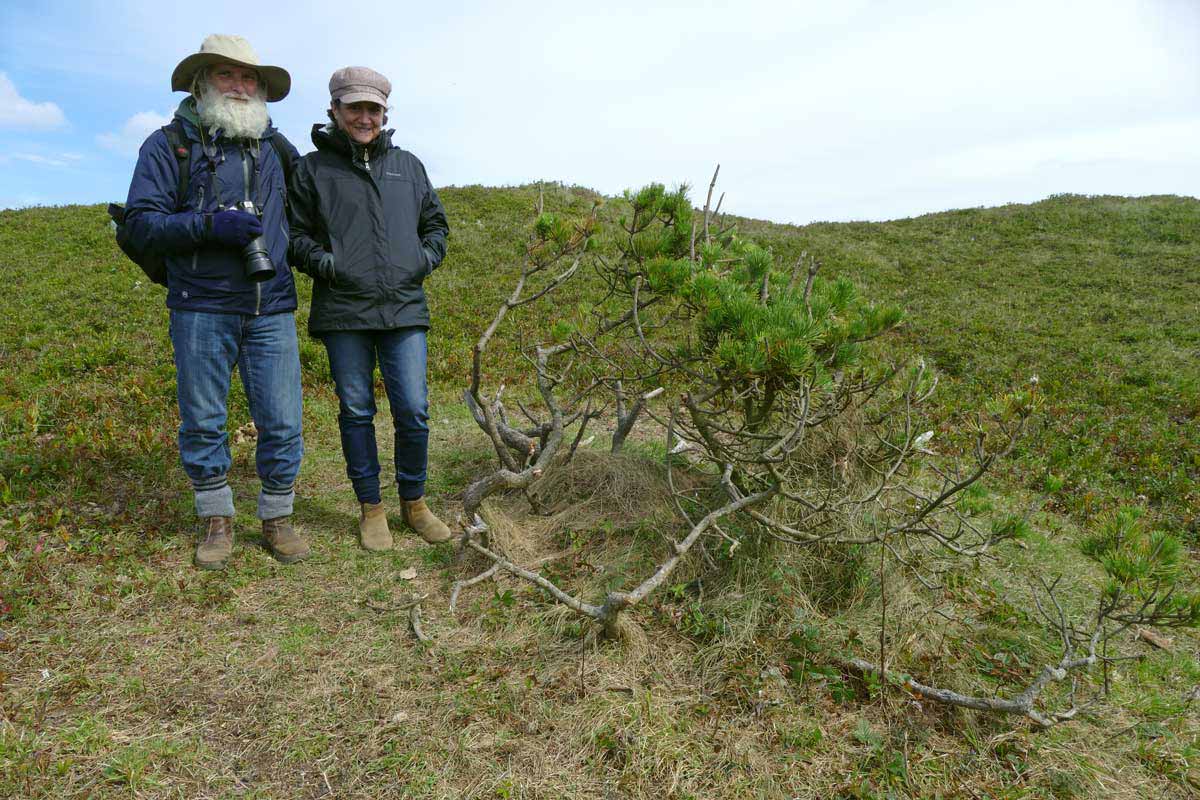 Robert and Pascale standing with the island’s solitary tree on a southwest facing bank at the east end of Pinetree Pond West. The pond is called “pinetree” because of this small, raggedy but persistent Scots Pine.
Robert and Pascale standing with the island’s solitary tree on a southwest facing bank at the east end of Pinetree Pond West. The pond is called “pinetree” because of this small, raggedy but persistent Scots Pine.
Robert & Pascale: ” ‘Lone Pine’ was a must-see for us since we were told about it in advance. Like many stories about Sable Island it is one reaffirming the tenacity and enduring spirit of life on the island. Like the horses of Sable, this tree has defied the odds, has found its protective niche and has survived.”
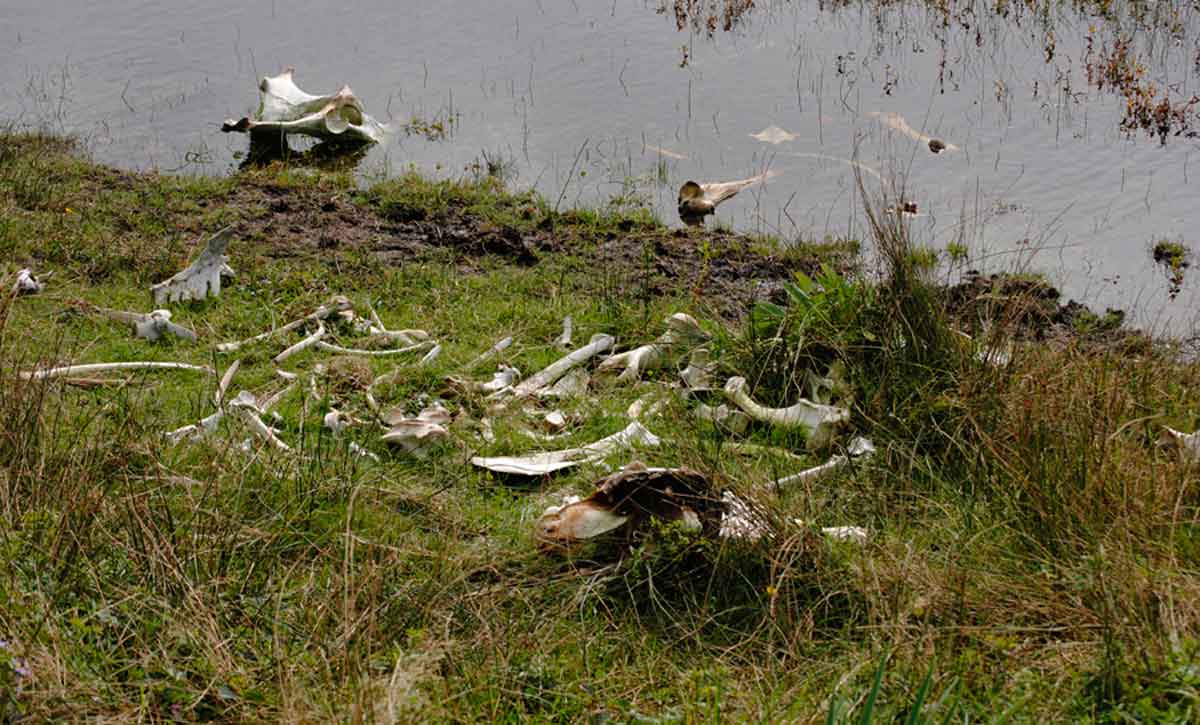 Horse bones at the north side of Pinetree Pond West (photo Robert Davis). The horse died a few years ago, and the bones have been scattered by horses walking through the area.
Horse bones at the north side of Pinetree Pond West (photo Robert Davis). The horse died a few years ago, and the bones have been scattered by horses walking through the area.
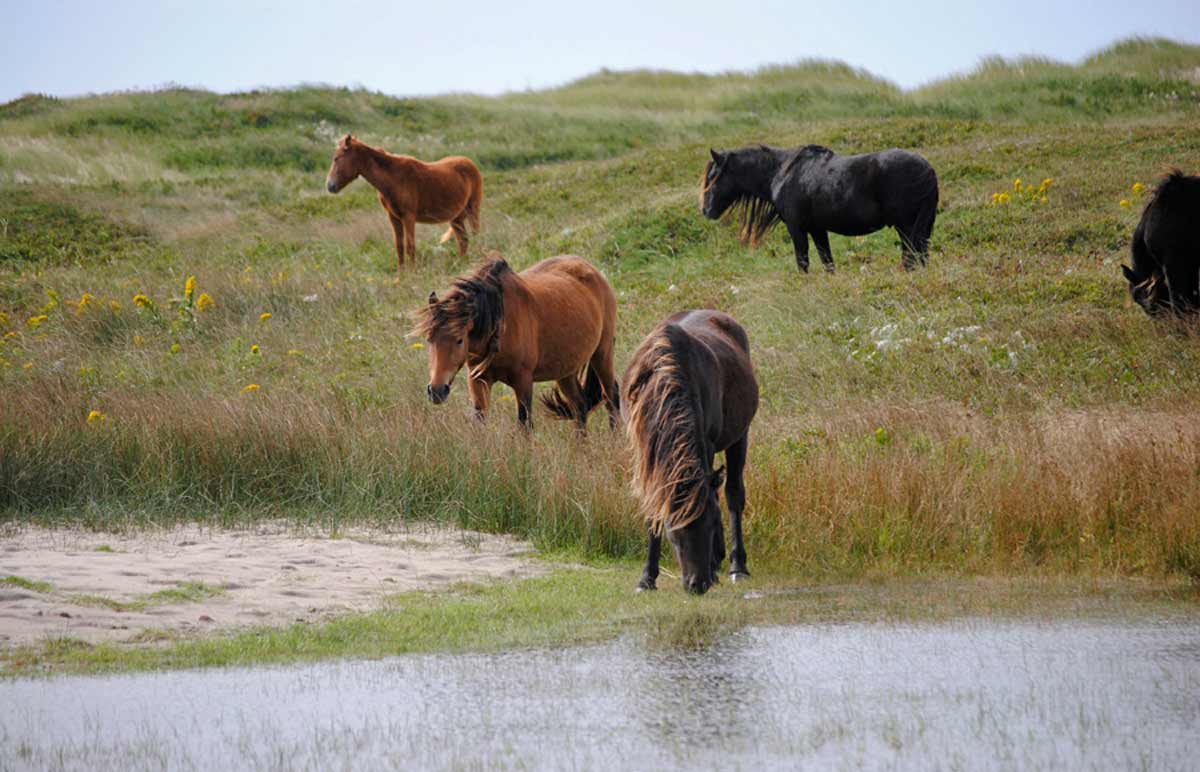 A family band of horses near the freshwater pond (photo Robert Davis).
A family band of horses near the freshwater pond (photo Robert Davis).
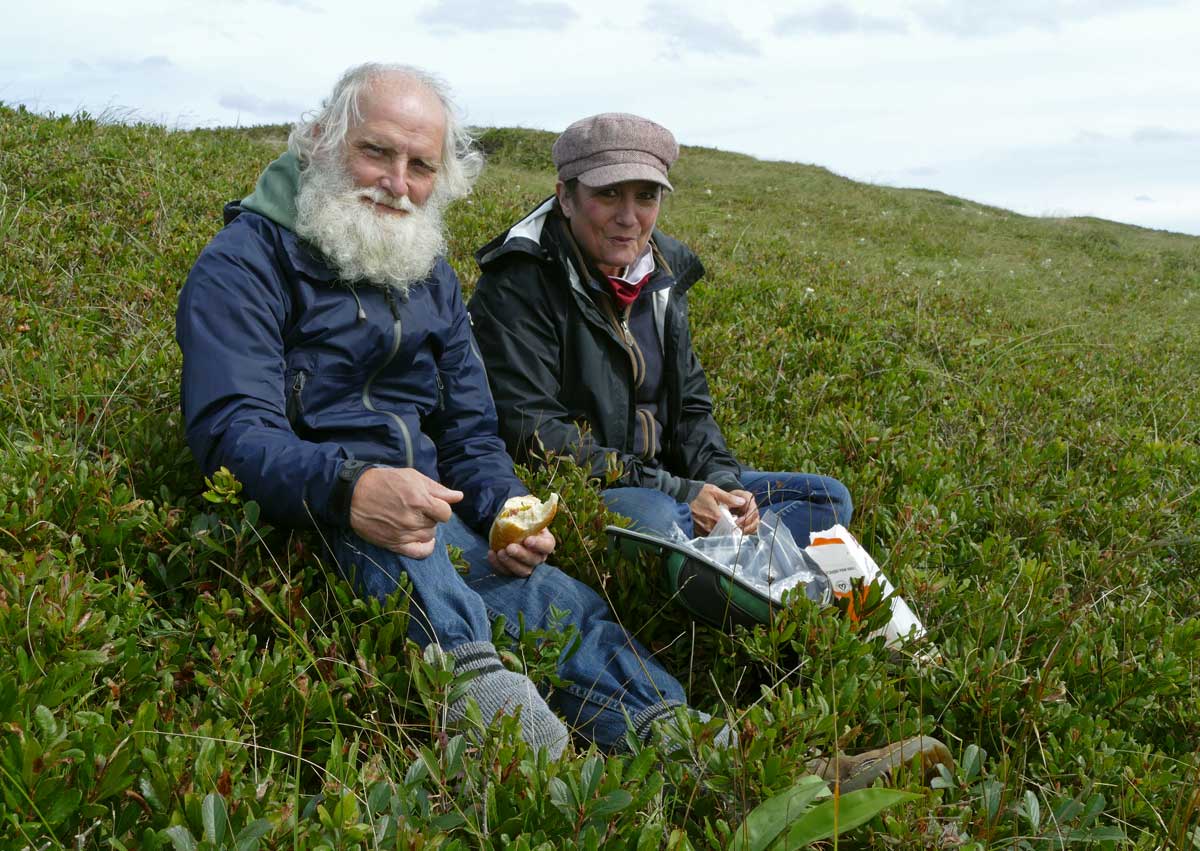 After a couple of hours of exploring, the group stopped to sit for a while on a sheltered south-facing slope at the north side of Pinetree Pond East. This pond is called “East” only because it is just east of Pinetree Pond West (where the tree is).
After a couple of hours of exploring, the group stopped to sit for a while on a sheltered south-facing slope at the north side of Pinetree Pond East. This pond is called “East” only because it is just east of Pinetree Pond West (where the tree is).
Robert & Pascale: “We are having our packed lunch, already hungry and refuelling for the busy day ahead. We will always remember the familiar smell of the bayberry and juniper, gently warmed in the late morning sun. It was spectacular weather for our visit with open blue skies, wispy clouds and embracing sea breezes.”
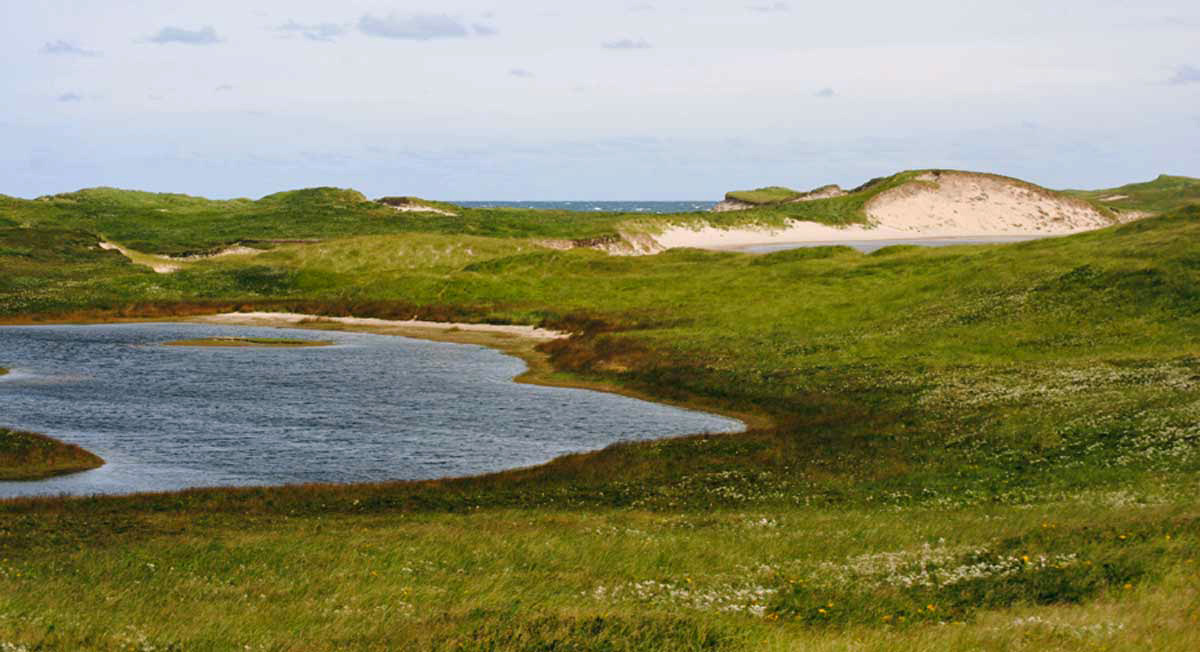 Looking towards the northeast, a view of Pinetree Pond East, with a distant glimpse of the choppy ocean along the north side of the island (photo Robert Davis).
Looking towards the northeast, a view of Pinetree Pond East, with a distant glimpse of the choppy ocean along the north side of the island (photo Robert Davis).
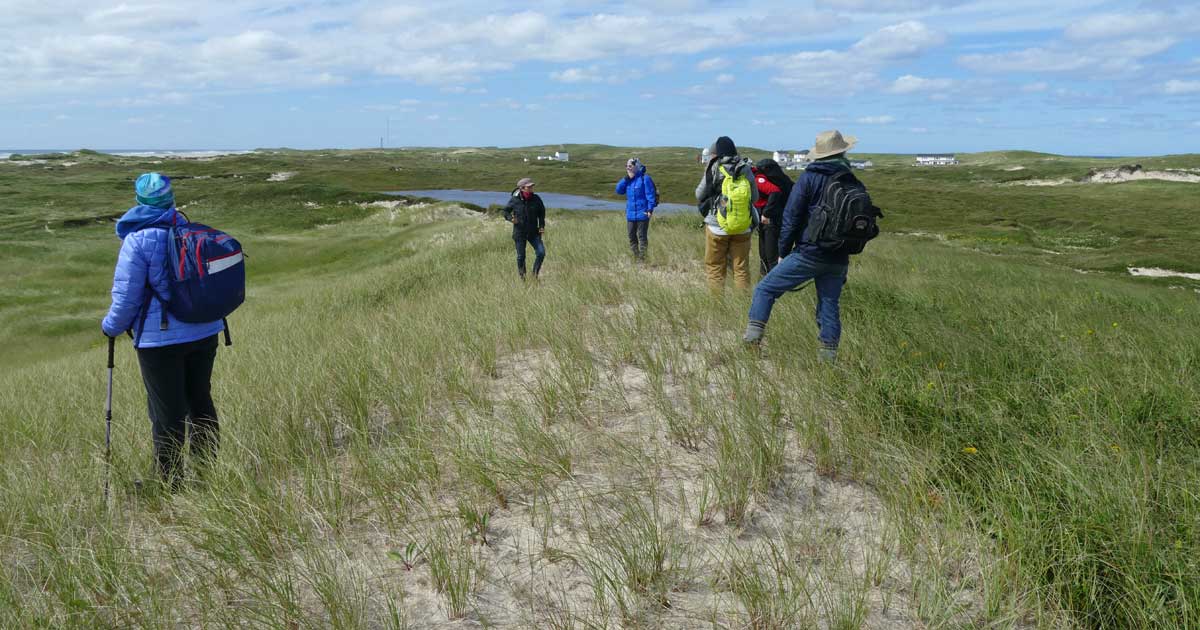 On a high, windswept south beach dune with a view to the west. The ocean and south side of the island are visible at the upper left, and the ocean and north side of the island are visible as a slim line of blue at the upper right.
On a high, windswept south beach dune with a view to the west. The ocean and south side of the island are visible at the upper left, and the ocean and north side of the island are visible as a slim line of blue at the upper right.
Robert & Pascale: “From a higher vantage atop a large dune, the view opened up and we had a great sense of openness. It is interesting how the island can feel so small and large at the same time. The combined sound of wind and waves was more evident. We could see the entirety of the Sable Island Station from here and many of the various scientific and data collection installations. Descending the hill, we stepped into a wind shadow and felt the warmth and protection of the lower elevations, beneath the wind and heated by the sun.”
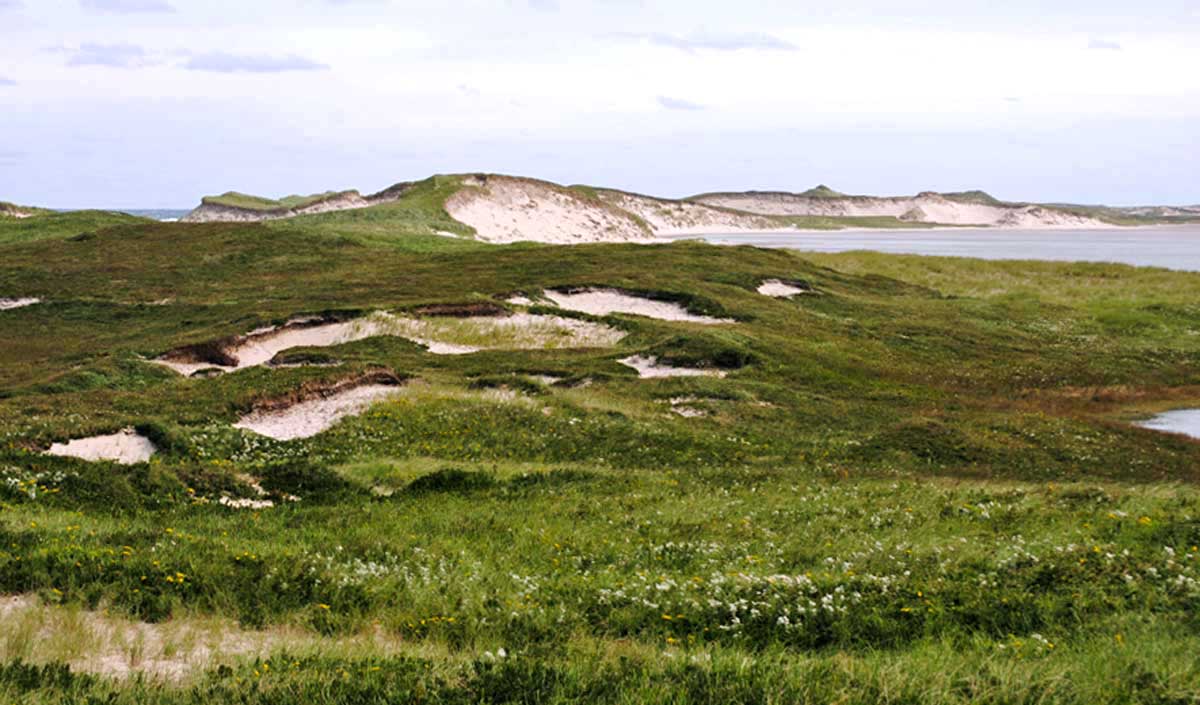 A view to the east showing the south beach area (upper right) where the fixed-wing aircraft would have landed if not for the flooding (photo Robert Davis).
A view to the east showing the south beach area (upper right) where the fixed-wing aircraft would have landed if not for the flooding (photo Robert Davis).
Robert & Pascale: “The long views of the island are awe-inspiring especially when combined with views of the ocean. We were always physically aware of where we were, but it was difficult to comprehend an island of sand and grass surrounded by the Atlantic Ocean so many miles from the mainland. Even as we stood on what appeared to be solid ground, we were constantly aware of the shifting sand beneath our feet. Everything appeared in constant motion, the wind, the grass and the little tumbling caterpillars we observed on the beaches.”
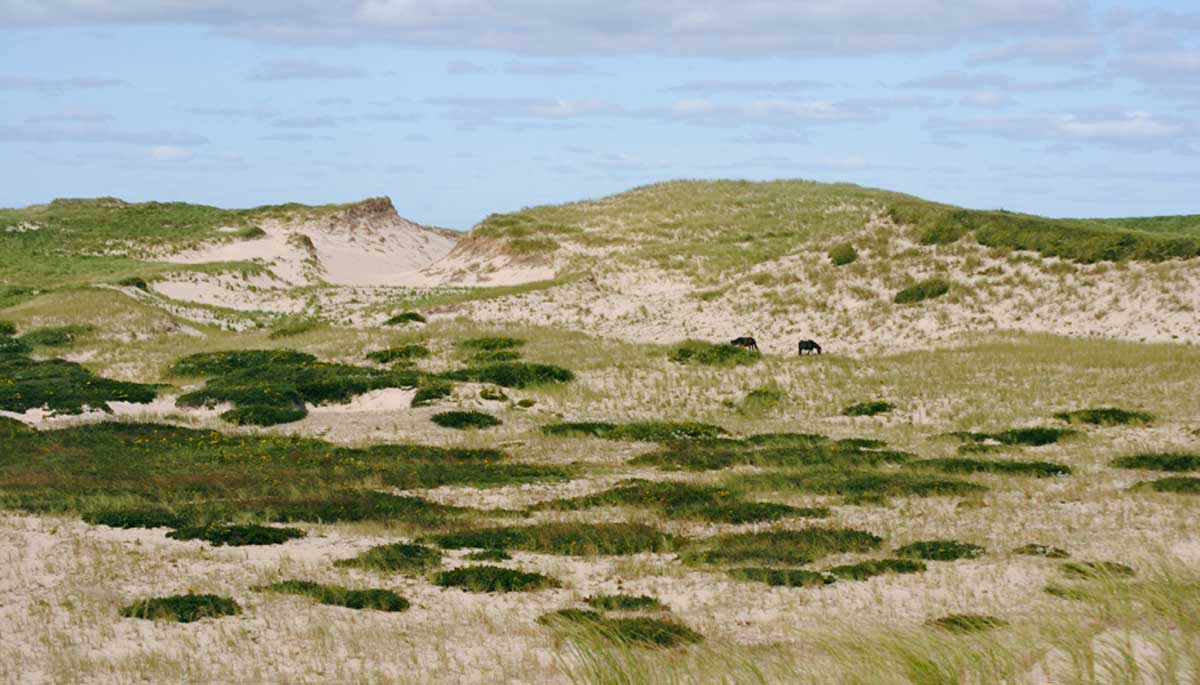 Two horses grazing marram grass in a low sheltered area inside the north beach dune line. The darker patches of vegetation are mostly bayberry with scattered Seaside Goldenrod and Pearly Everlasting (photo Robert Davis).
Two horses grazing marram grass in a low sheltered area inside the north beach dune line. The darker patches of vegetation are mostly bayberry with scattered Seaside Goldenrod and Pearly Everlasting (photo Robert Davis).
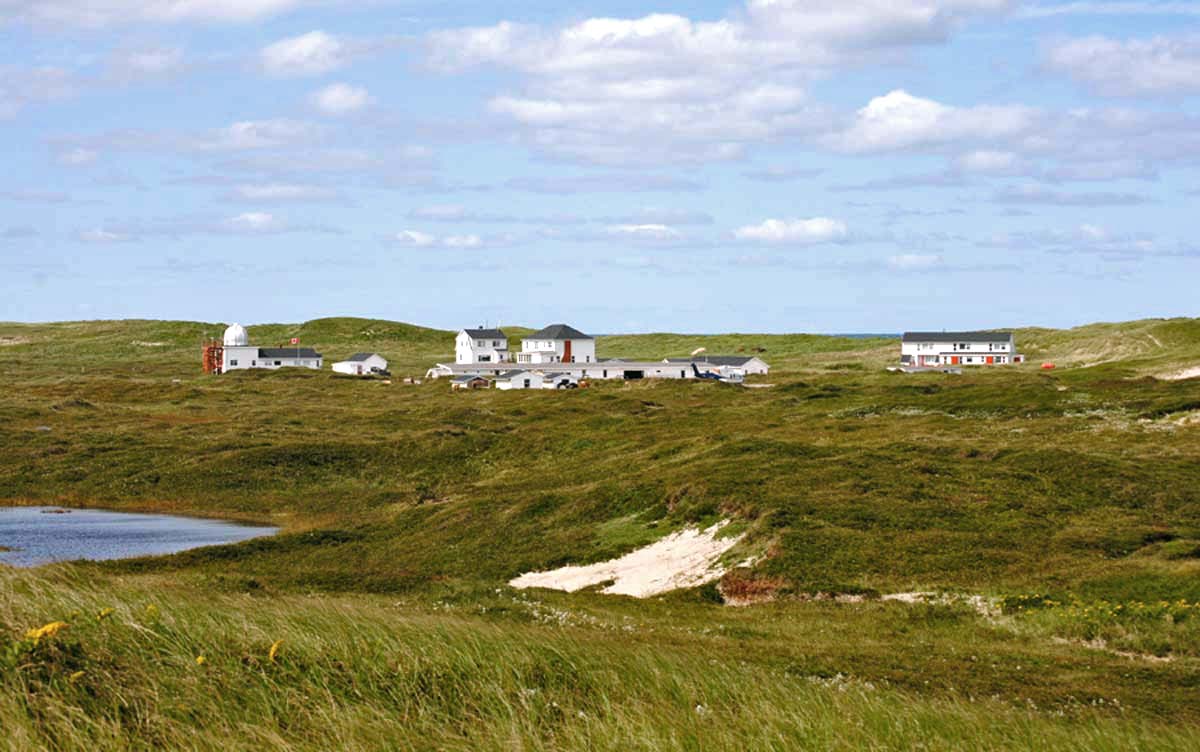 The Sable Island Station with most of its buildings in view, from the MSC office building with its iconic dome (on the left), to the Triplex accommodations unit (on the right) (photo Robert Davis). The VisQ is the large building in the middle with a red brick chimney up the side.
The Sable Island Station with most of its buildings in view, from the MSC office building with its iconic dome (on the left), to the Triplex accommodations unit (on the right) (photo Robert Davis). The VisQ is the large building in the middle with a red brick chimney up the side.
 After exploring the Pinetree Ponds area, the group returned to the sunny, sheltered spot at the station and took a break for some lunch, checking cameras, and relaxing before their longer hike westwards. Fred Stillman provided additional food and beverages.
After exploring the Pinetree Ponds area, the group returned to the sunny, sheltered spot at the station and took a break for some lunch, checking cameras, and relaxing before their longer hike westwards. Fred Stillman provided additional food and beverages.
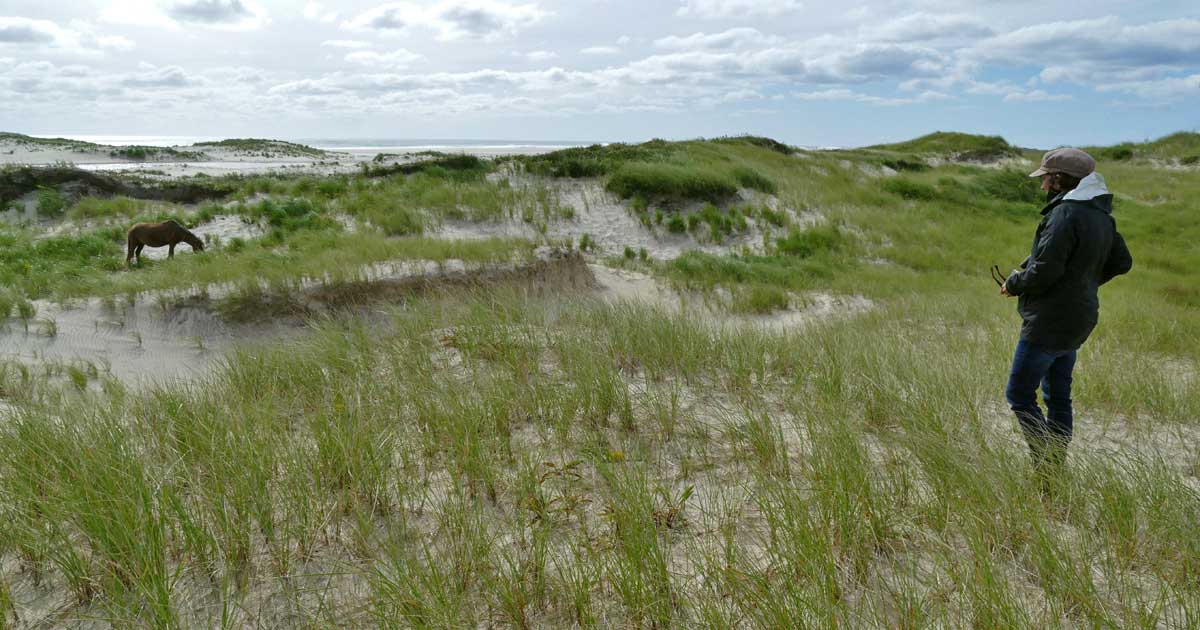 As the group walks towards the West Light area, Pascale stops to watch a Sable Island horse grazing marram grass. The south beach is in the distance.
As the group walks towards the West Light area, Pascale stops to watch a Sable Island horse grazing marram grass. The south beach is in the distance.
Robert & Pascale: “We were trying to take in the scene with an unaided eye as much as possible. We took as many photos as we could but it seemed photos alone could not capture the full emotions of the moment.”
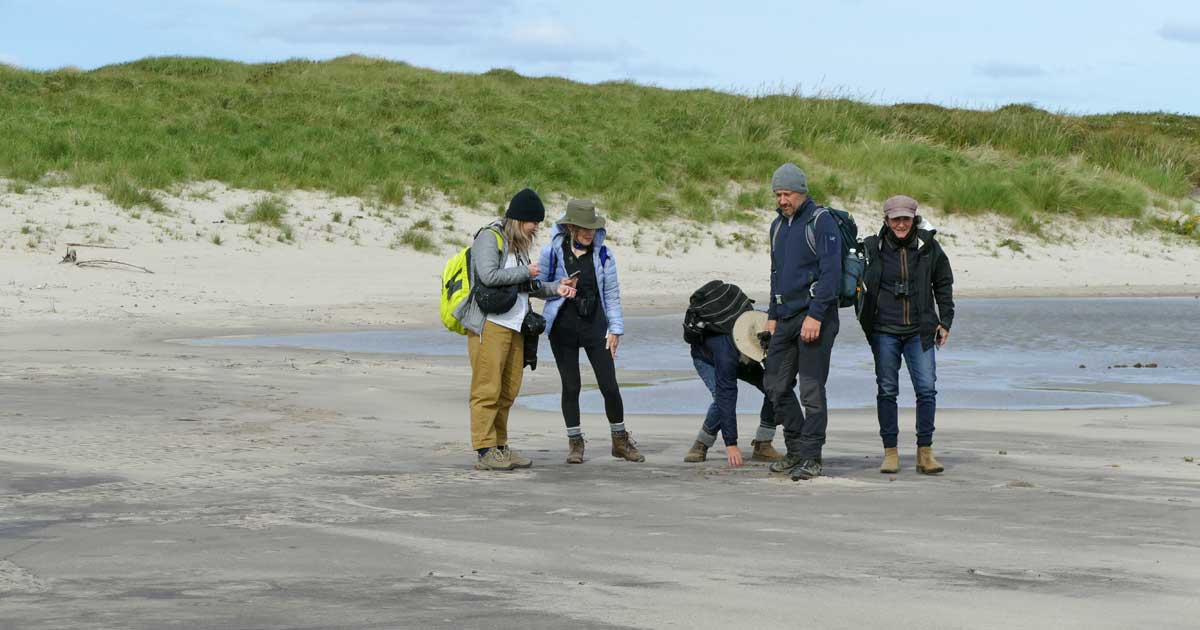 The group left the vegetated dunes and walked out onto the wide south beach sand flat where half-buried bones and heavy mineral sands were investigated. Fred Stillman, second from right, shares experiences and insights with the visitors.
The group left the vegetated dunes and walked out onto the wide south beach sand flat where half-buried bones and heavy mineral sands were investigated. Fred Stillman, second from right, shares experiences and insights with the visitors.

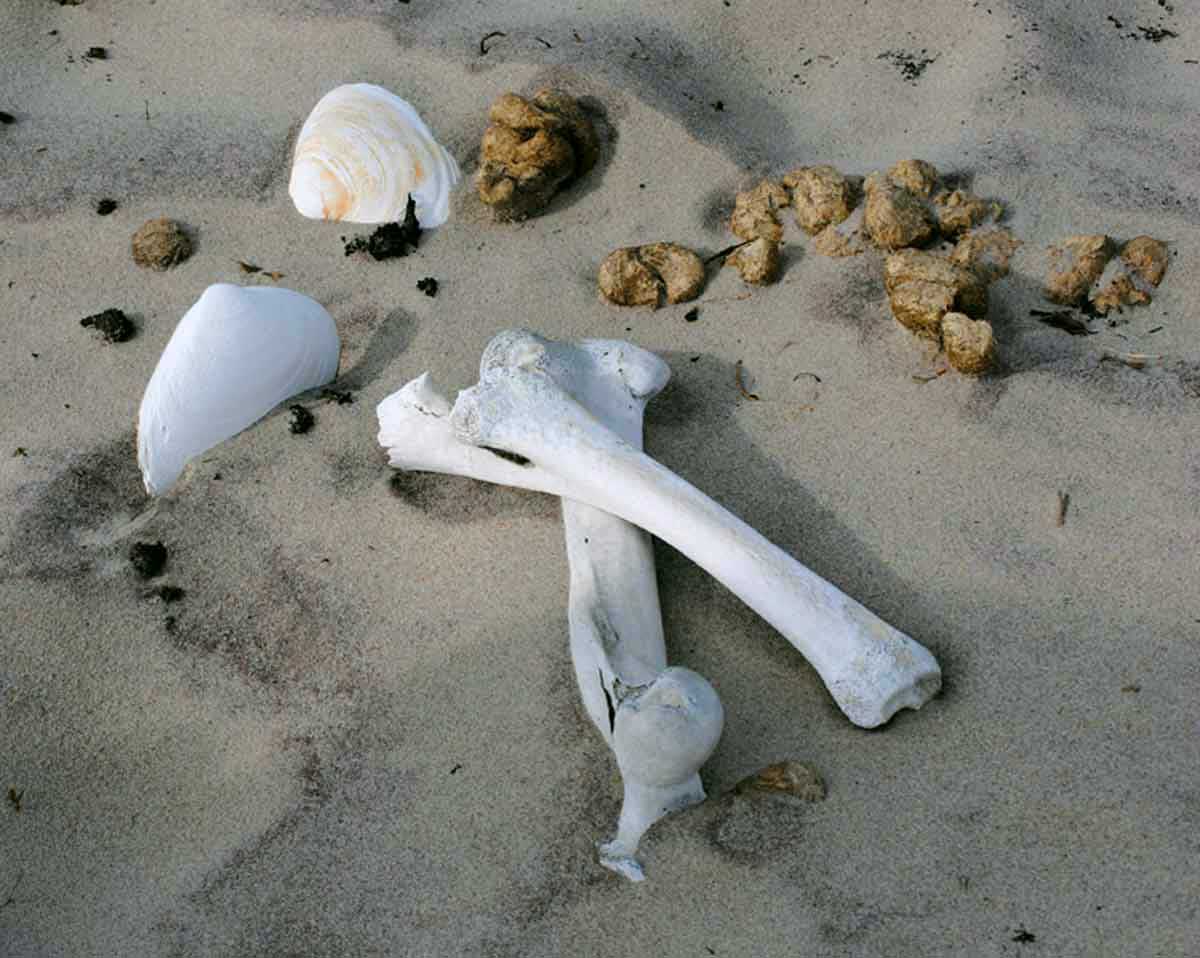 A still life – horse bones, surf clam shells, and buns (photo Robert Davis).
A still life – horse bones, surf clam shells, and buns (photo Robert Davis).
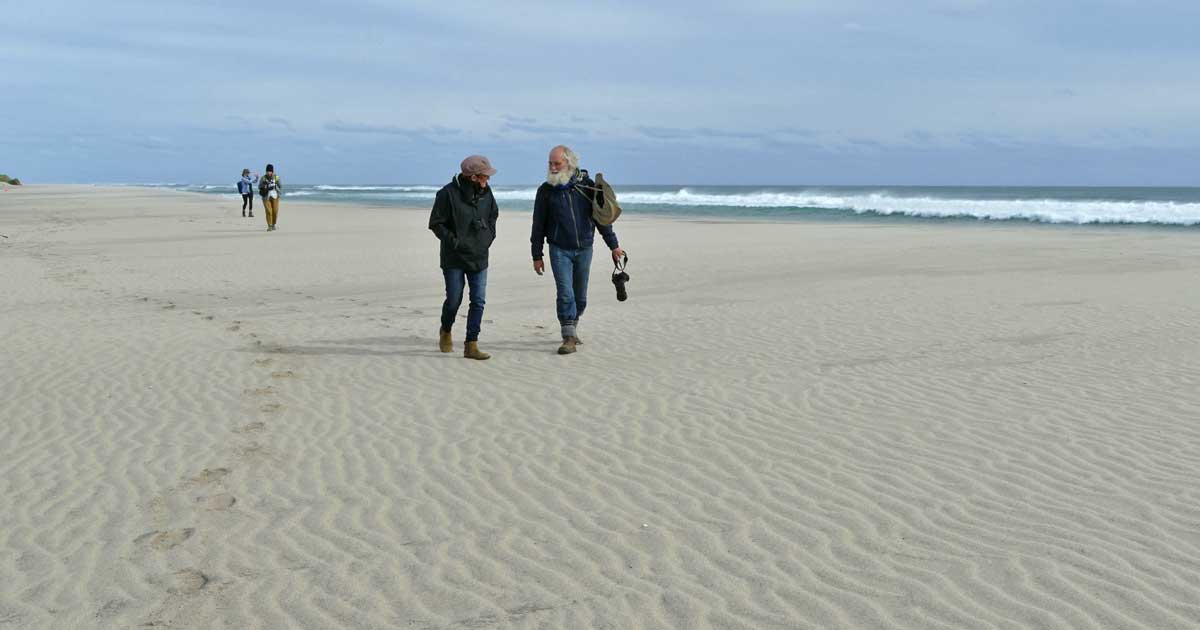 Pascale and Robert walking westward on south beach. The beach surface is rippled by the brisk northerly wind.
Pascale and Robert walking westward on south beach. The beach surface is rippled by the brisk northerly wind.
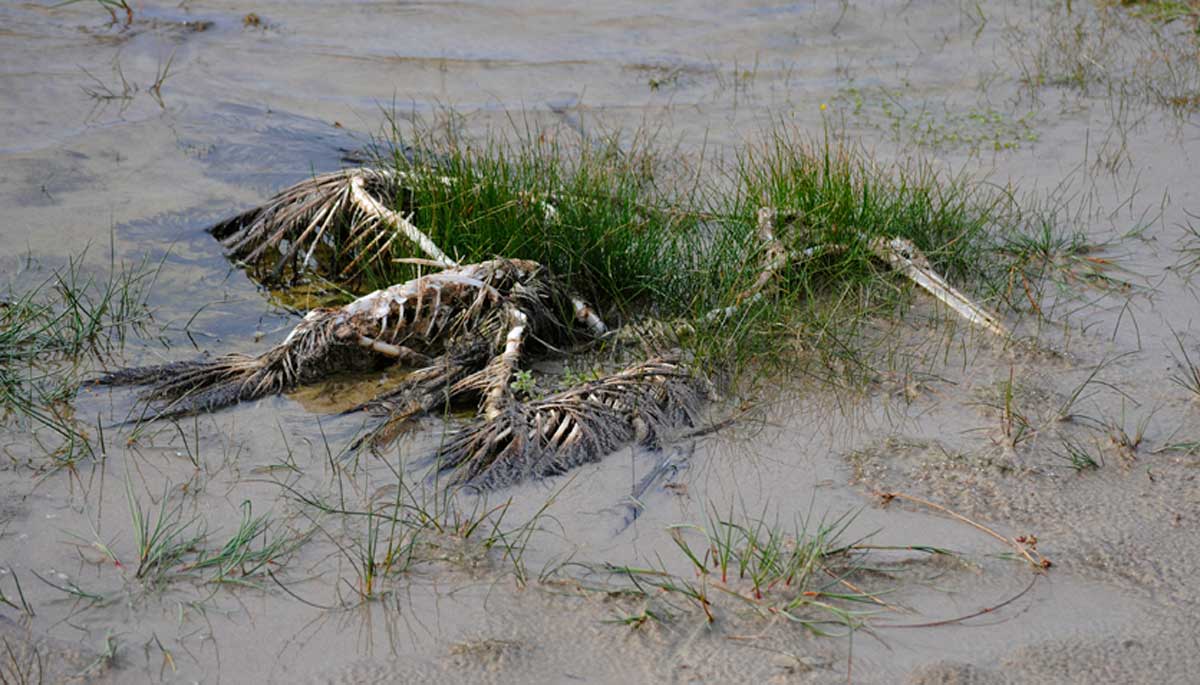 Bones and feathers, the remains of a Great Blue Heron near Acadian Pond (photo Robert Davis).
Bones and feathers, the remains of a Great Blue Heron near Acadian Pond (photo Robert Davis).
Robert & Pascale: “Horses of the island appeared in the majority of pictures we took during our visit since they were so accessible and grouped so close to the Sable Island Station. It was a fortunate circumstance that we took easy advantage of while observing a respectful distance. Most of the day, we travelled a network of horse paths that meandered everywhere in a relaxed and familiar way, so it was easy to witness horse behaviour, as well as insect and bird activity without disturbing anything. All cycles of life and death were on natural display as we peered at the undisturbed skeletal remains of horses, a Great Blue Heron, an immature tern, and various crabs and shellfish. Everything appears integral to the life of the island ecology and economy of use and decay.”
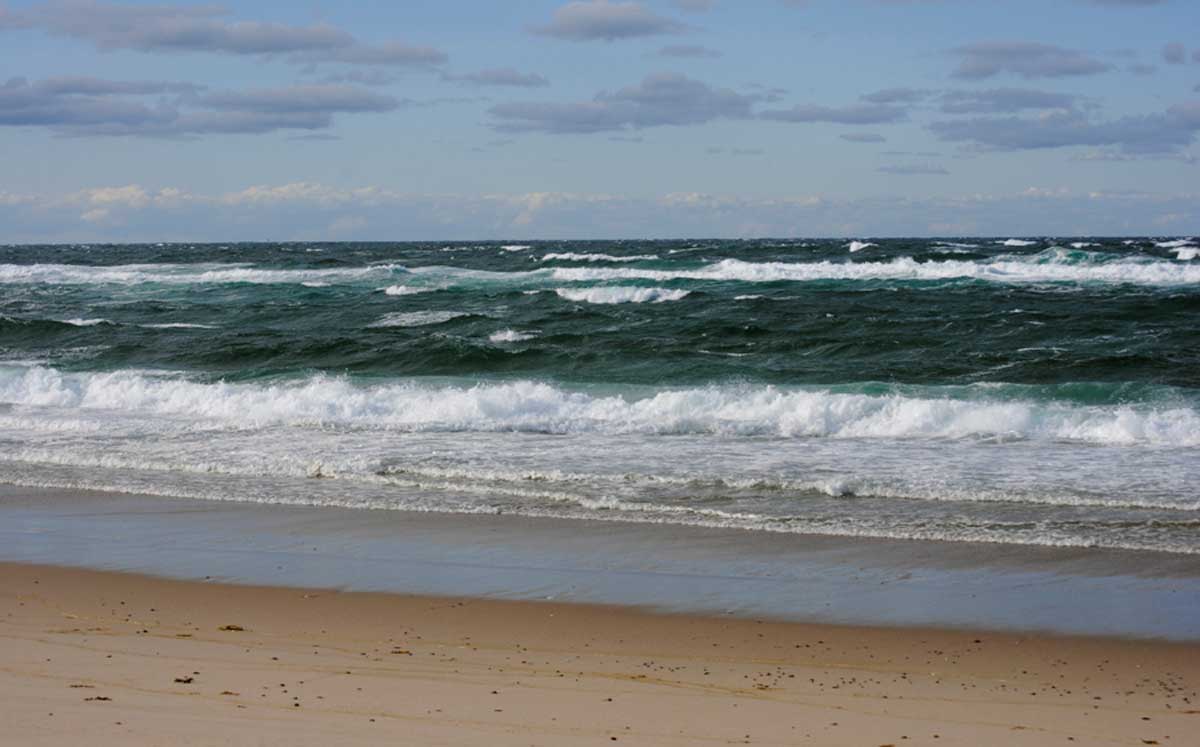 North beach (photo Robert Davis)
North beach (photo Robert Davis)
Robert & Pascale: “Briefly before our departure, a few of us still had energy to scramble along a deep sandy access road on the other side of the Sable Island Station to experience a view of North Beach. This allowed us to almost view the crescent shape of the island from tip to tip. The wind was strong and substantially louder than on the south side of the island due in part to the pounding surf and hissing air-borne sand particles. We wanted to stay longer but our time was limited by our imminent departure as well as the prospect of being exfoliated by the scouring wind. We observed three Grey Seals for a few moments before they performed a surprisingly athletic and undulating sprint from the beach to the water.”
 When they returned to the station, the visitors gathered to organize themselves for the flight back to Halifax. As they took a few minutes to rest and reflect on their Sable Island experience, everyone was offered a glass of champagne, a Kattuk tradition.
When they returned to the station, the visitors gathered to organize themselves for the flight back to Halifax. As they took a few minutes to rest and reflect on their Sable Island experience, everyone was offered a glass of champagne, a Kattuk tradition.
Robert and Pascale: “We did not want to leave once it was time to go. It seemed as if a part of us was left on a dune somewhere waiting to be retrieved again, one day, perhaps never. But it was comforting to have been so overtaken by the innocent beauty of the place, the timeless quality and seasonal pace of life there. We wished to experience more, to hunker down during an Atlantic storm, to feel the sere of winter, the closeness and concealment of foggy days, a sunset followed by sunrise. All of these things so familiar to a Maritime climate, but different through a Sable Island lens. How envious we felt for the life Zoe has made from her work and love of Sable Island. Her reality speaks of the same resilience and toughness that is essential to understanding and respecting the island and all of its inhabitants.”
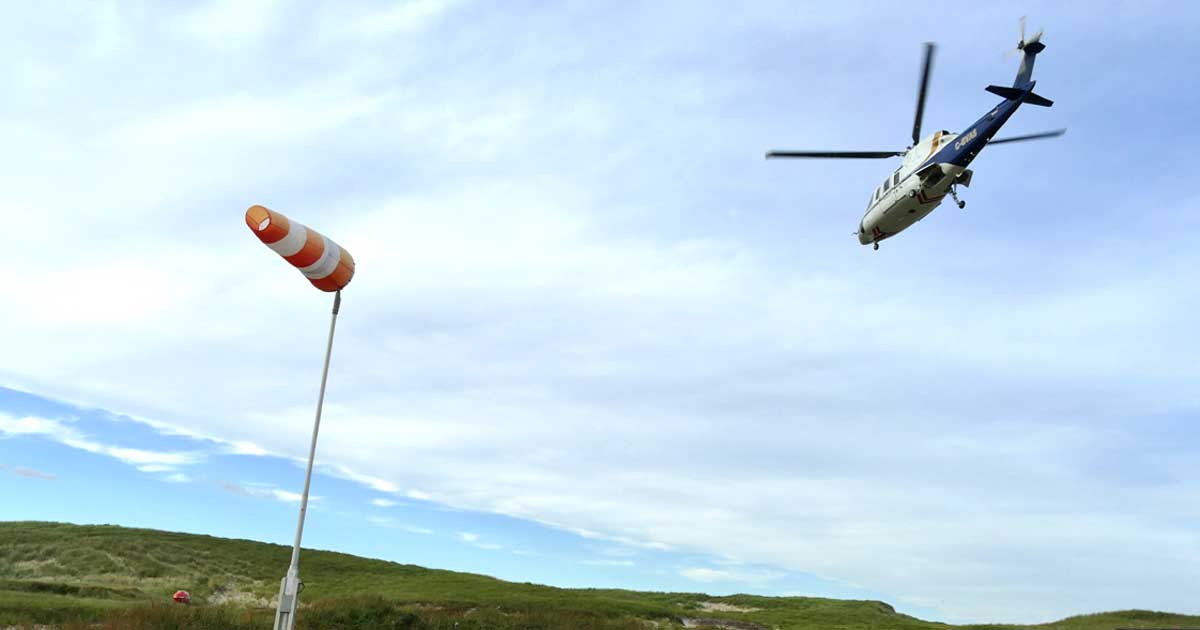 Departure, 5:30 pm. The helicopter takes off into the northerly wind.
Departure, 5:30 pm. The helicopter takes off into the northerly wind.
Fred Stillman (Kattuk): “Every trip to Sable seems to stand out in some unique way and this trip was special for a number of reasons. The sky was heavy and strong which added dynamic to every aspect of being there. The grasses had their late summer silvery shimmer and the wind could be seen travelling great distances through them. The horses seemed extra active that day, maybe it was the approaching storm? Another highlight for me was sneaking up the inside of a south beach dune near West Light to get a great view of a large grouping of Grey Seals. At one point we all sat down in a large, fragrant field of bayberry overlooking Pinetree Pond East and that was the first time I’d ever done that there. Everyone enjoyed and remembered it.”
Hurricane Teddy
Two days later, on September 22nd, Sable Island felt the effects of Hurricane Teddy. Although Teddy was not as severe as many past hurricane experiences, storm waves swept over the berm and flooded most of the south beach sand flat areas.
 On September 20th, Robert and Pascale had stopped to take a few photos as the group walked back to the station.
On September 20th, Robert and Pascale had stopped to take a few photos as the group walked back to the station.
 On September 23rd, the area is flooded with water still being driven over the berm by the wind. The arrow indicates roughly where Robert and Pascale had been standing three days earlier.
On September 23rd, the area is flooded with water still being driven over the berm by the wind. The arrow indicates roughly where Robert and Pascale had been standing three days earlier.
This account provides only brief notes about the visitors’ time on Sable Island. It was a wonderful day. The Sable Island Institute is grateful for having had the opportunity to contribute to, and participate in, this experience for Robert and Pascale, as well as for the other Kattuk visitors.
Thanks to everyone who purchased a ticket for the 2019 Trip for Two. Also, thanks to the many people who helped by promoting the raffle and selling tickets, and especially to White Point, Rand Gaynor, and Boom12. This event could not have been possible without the generous and enthusiastic support and expertise of Fred Stillman. The Sable Island Institute and Kattuk Expeditions appreciate the invaluable logistical support provided by Parks Canada personnel in the Sable Island National Park Reserve.
The proceeds from the ticket sales were used to support the Institute’s work, including studies of beached marine debris, part of the Beach Monitoring Program.
Even though it took a year to get our 2019 raffle winner to Sable Island, it was a great experience for everyone involved, and the Institute will collaborate with Kattuk again to offer another opportunity for a “Trip for Two to the Sable Island National Park Reserve”. Please watch for details in spring 2021.
Zoe Lucas
Sable Island Institute October 2020

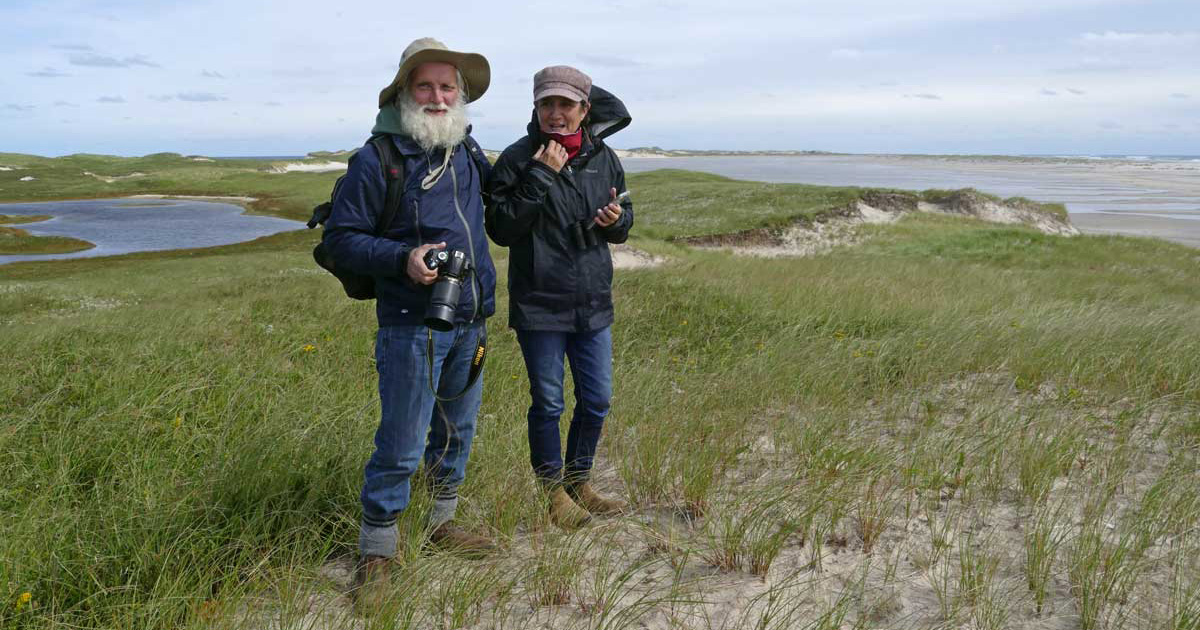

5 Responses
Fantastic, it sums it up beautifully
Thanks for this experience Zoe and Kattuk!!
An absolutely riveting description of your day at Sable Island. I am still hopeful that I will be able to rebook the trip I was to be on this past June but…Covid (since I live in Ontario and travel to Nova Scotia was not possible).
Beautiful! ………… a lifetime experience.
Wow! A trip of a lifetime for sure. Thank you for sharing.
thank you so very very much for letting us come on the trip with you. still on my bucket list
the photos are beautiful , thank you again
these memories will last you for ever